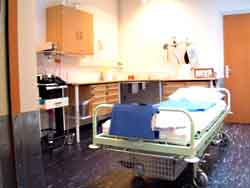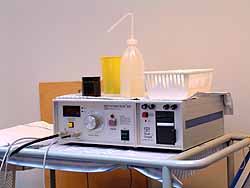18. Electroconvulsive therapy practiced in Denmark. 
ECT proves to be effective in treatment for depression. • General anaesthesia • How the treatment is implemented • For some it is the right treatment • Side effects • All kinds of medications are toxic • Electroconvulsive therapy 1938 • How many people receive Electroconvulsive Therapy

ECT proves to be effective in treatment for depression.
ECT, popularly known as electro-shock, is today especially used in treatment of severe endogenous depressions, where it has proven to be effective. Treatment with ECT cuts short the course of the condition in 90-95% of cases. Treatment with drugs works only for about 60-70% of patients, and then only after 2-4 weeks, whereas ECT has an immediate effect.
Following treatment with ECT about 50% of patients will have a relapse. This is a problem especially for those who suffer from antidepressant intolerance.
The earliest treatments that were provided were categorized as so-called dry shock. This referred to that fact that patients were not anesthetized, nor given oxygen or muscle relaxant medicine. Today's electro-shock is administered under general anaesthesia, and prior to the treatment the patient receives a muscle relaxing drug (curare).
At first ECT seems a quite violent treatment. But a study of patients after they have received ECT treatment shows that many felt that it was no worse than going to the dentist.

How the treatment is implemented.
Before administering ECT, the patient undergoes several physical examinations to minimize any risk in relation to anaesthesia. ECT usually consists of 10-20 treatments which can be provided to both inpatients and outpatients. As in surgery, the patient should not eat or drink for a few hours prior to treatment.
Before the treatment starts, anesthesia is provided through an intravenous drip which makes the patient fall sleep and the body’s muscles relax. Once anesthesia is fully working electro-shock is provided through electrodes on the patients head.
The electrical stimulation produces changes in the brain waves. These changes induce epileptic seizures. It is thought that the seizures bring about the patients’ improved condition.
After approximately 30 minutes the patient awakes and, although he may at first be somewhat confused, he is usually immediately well enough to eat and can go home if he is an outpatient
For some it is the right treatment
Professor, Tom Bolwig, Rigshospitalet in Copenhagen, Denmark:
„"… For some patients, ECT treatment is the right treatment because it is the only one that works. This is primarily seen in cases of severe depression, risk of suicide or risk of physical harm, as seen in some of the depressive patients who are not able to eat or drink. If medical treatment can’t be used, ECT is without doubt the best treatment, and probably also the most well documented in psychiatry, related to these types of complaints ..."“
Bente Djørup, President of the National Association for Mental Health called “SIND”:
"… For many years we have in our magazine “SIND” been discussing ECT treatment and overall we don’t disagree with these viewpoints. Some members feel that ECT should be banned. But as many hold the view that it ought not to be banned because they have experienced it as a good treatment. Therefore our stance is that it should be offered to people who need it …"
"… Sometimes the debate gets a bit one-sided when it comes to treatment within psychiatry. Concerning the somatic area it is accepted that one can choose oneself. ECT sounds so violent and intrusive and it can appear strange that some ask for it – according to many such a choice should not be permitted …”

The most frequently seen side effects from electro-shock therapy are amnesia and cognitive difficulties. The side effects usually wear off after a couple of months. By using one-sided stimulation, in recent years it has been possible to reduce memory problems, but this form of the therapy requires repeated treatments.
So far there is no evidence that ECT can cause brain damage.
The National Association for Mental Health are regularly approached by patients and their families, describing a wide range of side effects that differ from those mentioned above.
SIND also receives inquiries from patients and relatives who say that they have not received the necessary information before being treated and some haven’t had any information at all.
All kinds of medications are toxic
Professor, Tom Bolwig, Rigshospitalet:
"… In minor or moderate cases of depression, ECT doesn’t provide a better outcome than medication alone. However, in more severe cases it is well documented that the effect is greater. In the short term there will be an unpleasant side effect where the memory is disturbed. But in general one can say that within two weeks it is possible to function completely normally again …"
"… A number of patients describe that the side effects they had from the medication, especially the type of drugs provided a couple of years ago, are far worse than the couple of weeks where the memory fails. There will always be a price to pay when being treated for a serious illness. All medicine is poisonous. When doctors give medication the target is to poison unwanted mechanisms. Unfortunately, you cannot construct a medication that only affects exactly where the problem is …"
Electroconvulsive therapy 1938
ECT, also called Electroshock Therapy or Electro Stimulation, is short for Electric Convulsive Therapy. ECT developed on the basis of Lazlo Medunas’ experiments with electrically induced seizures on the basis of studies from the 1930s of glia tissue in epileptic patients and patients with schizophrenia. The method was further developed by the Italians Cerletti and Bini and from its outset Electroconvulsive Therapy gained widespread use all over Europe due to the proven efficiency of this form of treatment. Source: National Association for Mental Health, No. 4, pp. 18. May 2002, 31 edition.
How many people receive Electroconvulsive Therapy
In Denmark, in 1999, approximately 1700 patients were treated with Convulsive Therapy. This corresponds to approximately 16.000 treatments per year or about 44 treatments per day. In comparison with other countries, several studies over the last 20 years show that ECT is used more frequently in Denmark.
On an average, 5% of all hospitalized mentally ill patients in Denmark received ECT in 1999.